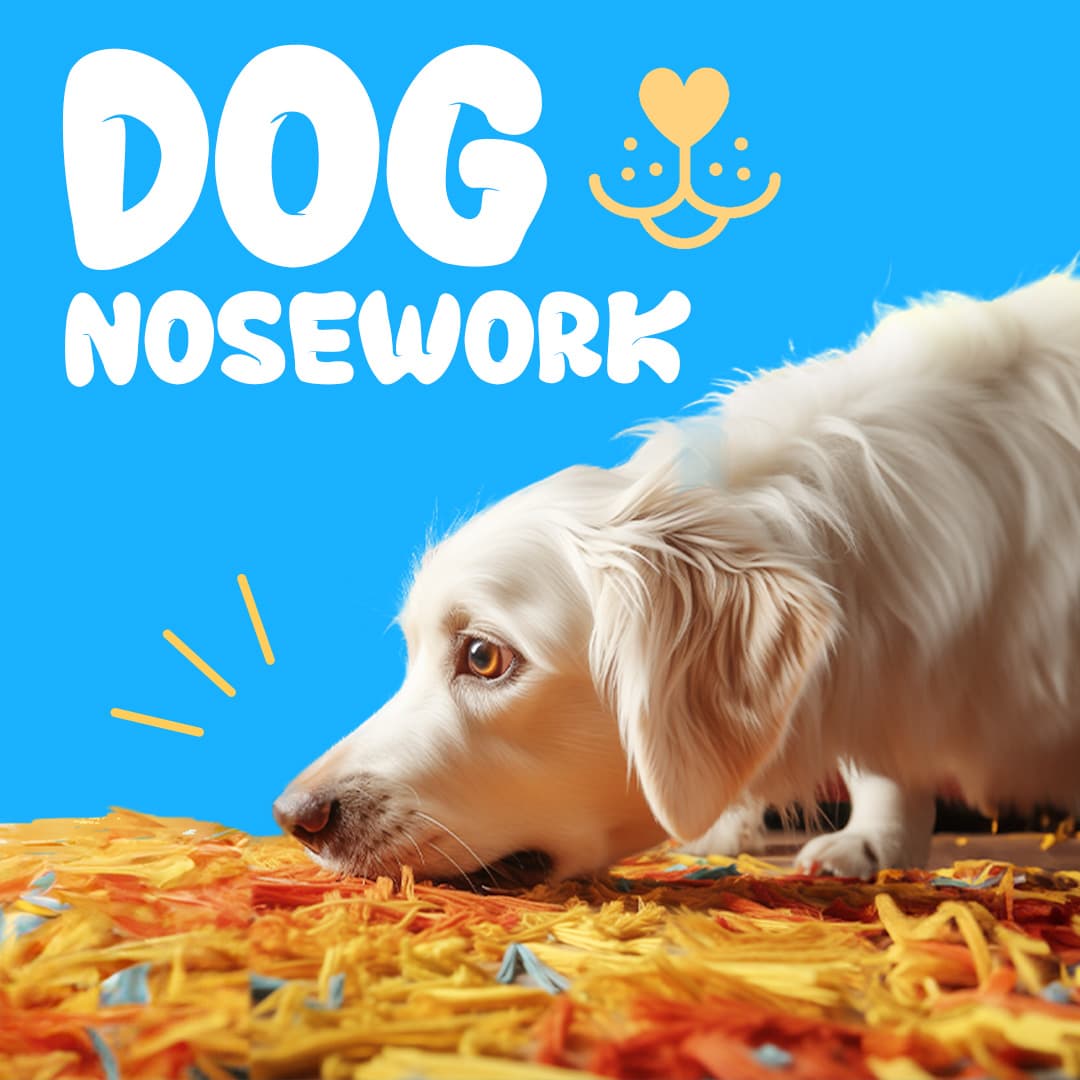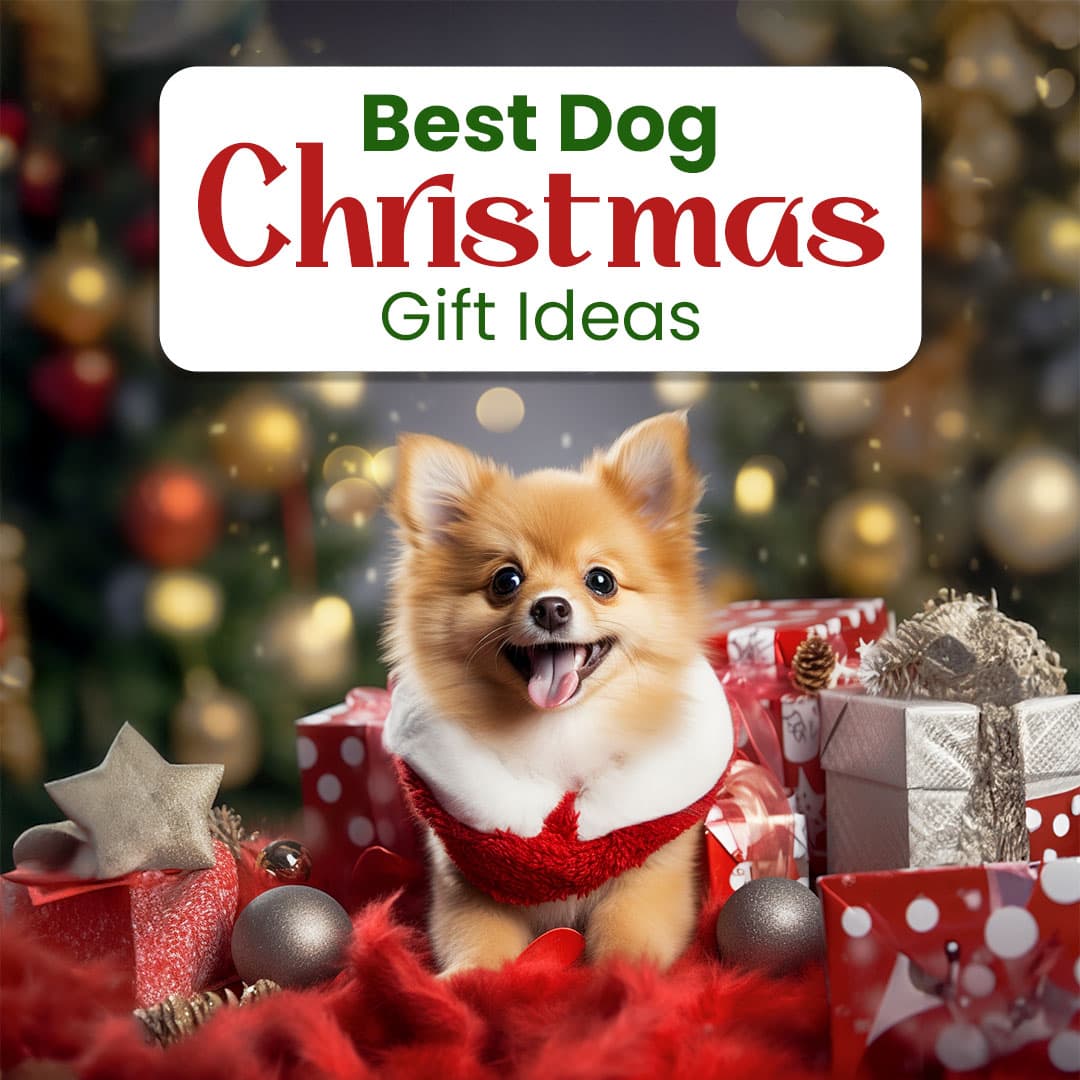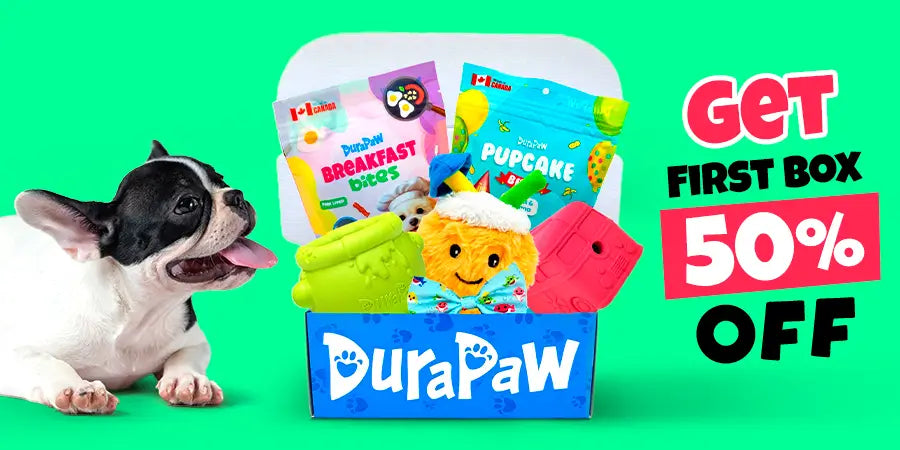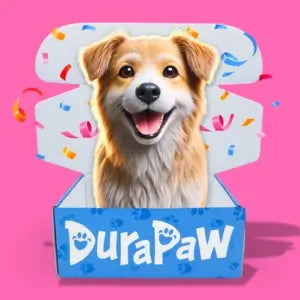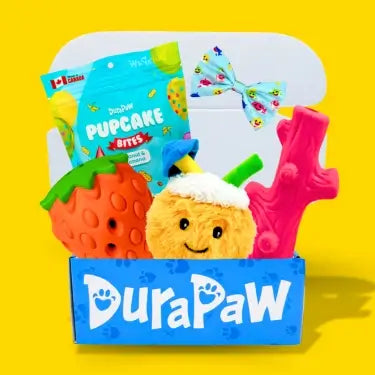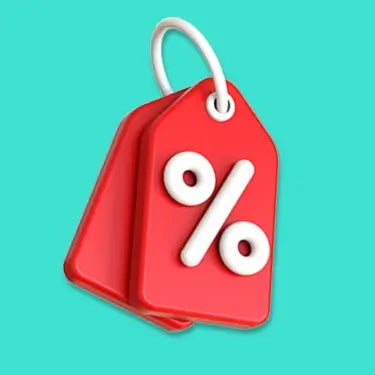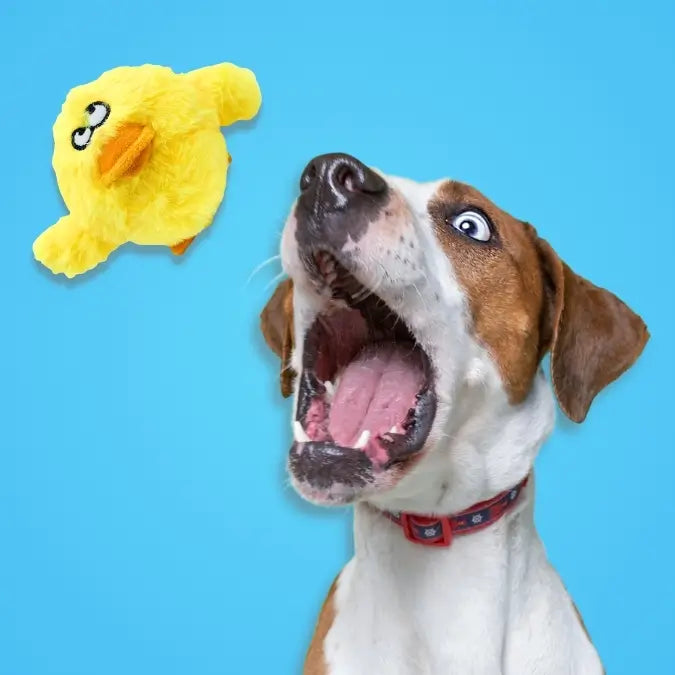Dog Toys: Ultimate Guide For Durable and Engaging Dog Toys
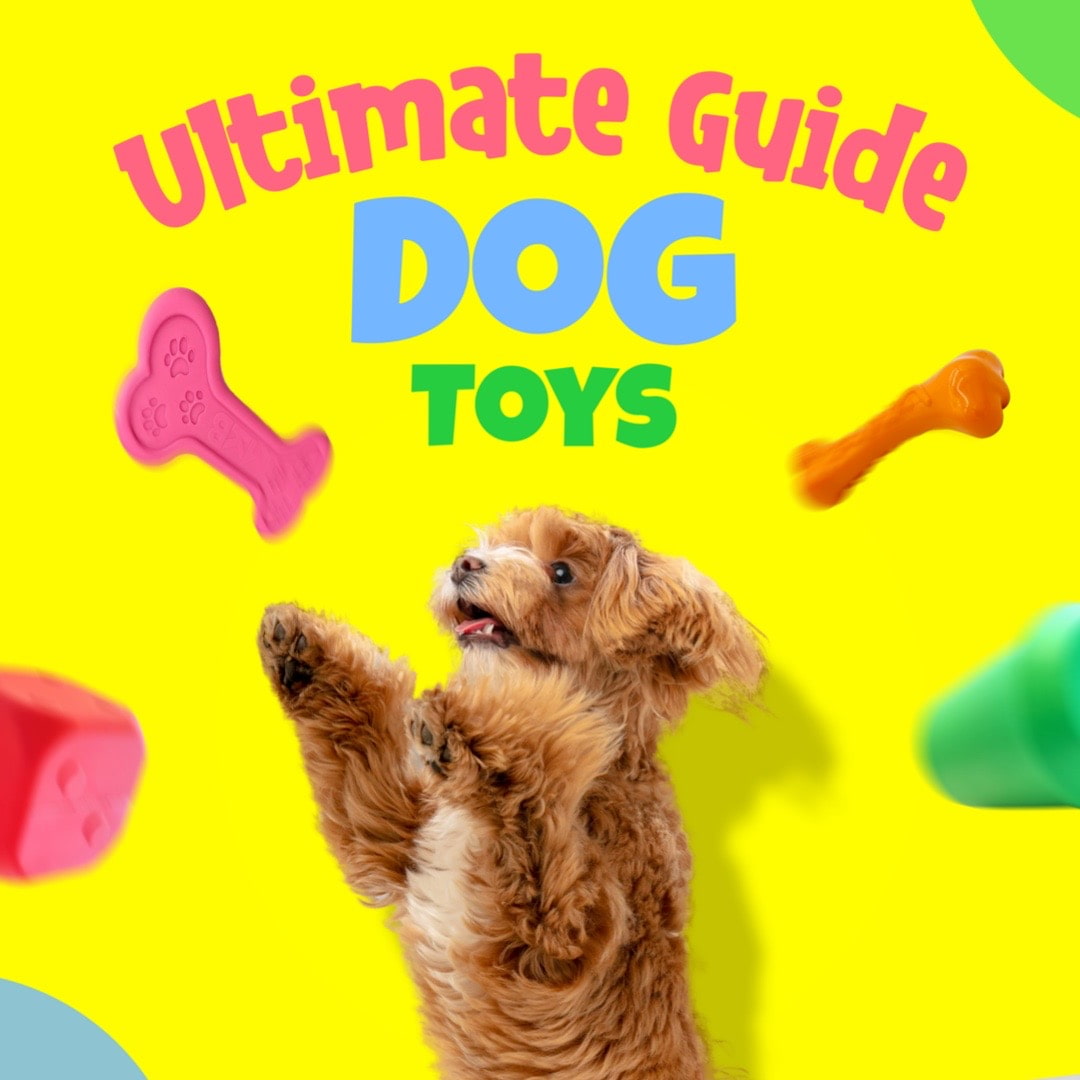
Dog Toy Guide Introduction
Choosing the best suited toys for your dog is a fun yet important task. To make sure your pup enjoys their playtime to the fullest, it's essential to select the most appropriate size and material that aligns with your pup's chewing habits.
Types of Dog Toys

Nylon dog toys
Durable and long-lasting, these toys are perfect for heavy chewers and pups that will chew on anything and everything.
Hard rubber dog toys
Designed to withstand strong jaws, these toys provide a satisfying chewing experience with a little more 'give' than a hard nylon toy.
Treat dispensers
These toys combine play and reward, challenging your dog to work for treats or kibble hidden inside, promoting mental stimulation.
Squeaky toys
Dogs love the sound of squeaky toys, providing auditory stimulation while satisfying their natural instincts.
Plush dog toys
Soft and cuddly, plush toys are comforting and suitable for gentle chewers, providing comfort and companionship.
Tug Rope dog toys
Great for interactive play, tug ropes are ideal for bonding with your dog and can help improve their dental health.
Dog lick mats
Lick mats can be spread with your dog's favorite treats, offering a calming and mentally stimulating activity, especially for anxious dogs.
Snuffle mats and balls
Snuffle mats and balls hide an abundance of kibble and treats within fabric pockets, encouraging your dog's natural foraging instincts.
Choosing the Right Toy
Size Matters
Begin by considering your dog's size. Larger breeds may require more substantial toys, while smaller ones should have appropriately sized options. Toys that are too small can pose a choking hazard, so it's crucial to get the size just right.
Chewing Style
Some dogs are gentle chewers, while others are more vigorous. For gentle chewers, soft and plush toys may be ideal, while vigorous chewers may benefit from durable nylon or hard rubber toys.
Age-Appropriate
Keep your dog's age in mind. Puppies, for example, may require softer toys to soothe teething discomfort, while teenage dogs may prefer more challenging puzzle toys for enrichment and mental stimulation.
How to choose the most durable dog toys for puppies?
Choosing durable dog toys for puppies is essential, especially during their teething phase when they tend to be enthusiastic chewers. It's essential to find a balance between toys that are easy on their young puppy teeth while remaining robust enough to endure constant chewing.
What toys do dogs like the most?
Preferences for toys can vary greatly depending on your dog's individual personalities and play styles. However, some toys tend to be universally popular among dogs:
- Balls
- Squeaky Toys
- Squeaky Toys
- Plush Toys
- Fetch Toys
- Treat Dispensers
Safety Guidelines
No small parts
Carefully select toys without small detachable parts that your dog could swallow or choke on.
Supervise play
Always supervise your dog during playtime, especially with new toys. This allows you to intervene if the toy shows signs of wear or if your dog becomes too rough during play.
Replace damaged toys
If a toy becomes torn, frayed, or has loose parts, replace it right away to prevent potential choking hazards.
Avoid toxic materials
Stay away from toys with potentially toxic materials that could be harmful. Look for toys labeled as safe for pets.
Regular cleaning
Ensure to clean your dog's toys regularly to prevent buildup of dirt and bacteria. Refer to the manufacturers cleaning recommendations for more information.
Interactive and Enrichment Toys
Interactive and enrichment toys play a vital role in keeping your dog mentally and physically engaged. They stimulate your dog's cognitive abilities and natural instincts. Here are some enrichment toys to consider:
Puzzle Feeders
These toys dispense treats or kibble as your dog 'boops' them around. They challenge your pup's problem-solving skills, encouraging mental stimulation while rewarding them with tasty treats.
Hide-and-Seek Toys
Hide and seek toys with hidden compartments to hide smaller toys or treats are fun and interactive toys for your dog to enjoy.
Interactive Feeding Mats
These mats require your dog to work for their meal by foraging for kibble or treats scattered across the mat's surface. This sensory activity engages their sense of smell and provides mental stimulation.
DIY Dog Toys
Creating your own homemade dog toys can be a rewarding and cost-effective way to provide your furry friend with entertainment. Here are some fun and simple DIY dog toy ideas:
Sock Ball
Place a ball, whether a rubber ball or tennis ball, inside of a sock and tie the open end. Now you've got a bouncy, interactive toy that's easy to throw, play and fetch.
Tennis Ball Treat Dispenser
Cut a small slit in a tennis ball, insert kibble or treats, and let your dog roll and play with it to release the treats gradually. Carefully monitor your dog during play to ensure they do not tear any loose pieces apart.
Crinkly Bottle Toy
Place an empty plastic water bottle inside an old sock, tie the sock closed, and let your dog enjoy the crinkly sounds as they play.
How to safely use DIY homemade dog toys
When making your own DIY dog toys, always prioritize safety. Avoid using materials that could be harmful if ingested or cause potential choking hazards. Additionally, supervise your dog during playtime with these toys to ensure their safety and enjoyment.
Toy Maintenance
How to clean rubber dog toys?
Let's face it, rubber treat dispensers can get messy! Most rubber dog toys can be cleaned with warm water and mild soap. But not all rubber toys are made with the same materials. There are different rubber compounds, formulas, and mixtures that may require a different approach for safe cleaning. Always refer to the manufacturers guidelines for how to clean your dog's toy.
How to clean nylon dog toys?
Nylon dog toys can also come in different formulas, whether they are infused with flavors, bamboo, wood chips, or pure solid nylon. In general, spot cleaning stained areas should be okay, however its best to refer to the manufacturers guidelines for safe advice.
How to clean snuffle mats?
Generally, snuffle mats made of polar fleece and plush material can be spot cleaned with warm water and mild soap. Although washing machines are convenient, it's best to refer to the manufacturers cleaning recommendations to check whether they can be washed in your washing machine.
What Not to Give Your Dog

Your dog may likely chew and eat anything you give them, however not everything is safe for your pup to chew. It's important to be aware of potential hazards to prevent or avoid any incidents altogether. Below is a list of some items you should avoid letting your dog chew or eat:
Cooked Bones
The dangers with cooked bones is they can splinter into small and sharp fragments. These fragments could be ingested and pose an immediate choking hazard, or become a blockage in your dogs digestive track. In addition, bones can also cause Irritable Bowel Syndrome (IBS) or further upset an already irritated stomach.
Wooden Sticks
Wooden sticks can also splinter and either be swallowed or cut your dogs mouth, leading to possible infections and internal blockages.
Rocks
Chewing rocks can be dangerous and lead to chipped or broken teeth. As with the unsafe objects above, it can also cause blockages, or sharp edges can cause perforations in your dogs stomach or digestive track.
Small Objects
Small objects, and toys with small components that can come loose, can be hidden choking hazards for your dog. It is important to keep your dog's area safe and clear of any small toys or items, and regularly inspect toys for rips and tears.
Toxic Plants and Foods
Decorating your house with beautiful plants can be fun, but it is important to be aware of what types of plants you buy and where you locate them. Some plants can be toxic to dogs and its best to avoid them altogether for the sake of your furry friend.
Children Toys
Children toys and dog toys can sometimes look alike, but they are always designed with the end user in mind. Children toys can be made of different materials and sometimes feature small pieces which can pose to be a choking hazard for your dog. It is important to keep these toys separate from one another.
Plastic Bags
You dog might love the crinkly sounds of a grocery bag, however these can be extremely hazardous to play with. If left unattended, your dog could accidentally wrap the bag around their head and suffocate. Small piece of plastic may also be ingested and cause internal blockages or intestinal issues.
Dog Toys: Frequently Asked Questions
Why do dogs love to chew?
Dogs have a natural instinct to chew for several reasons, including boredom, teething, stress and anxiety, and to taste or explore things. Providing safe and durable toys for your dog to chew is essential to prevent them from eating things they shouldn't.
What age do puppies need chew toys?
You can introduce puppy safe toys when you bring your new furry family home around 8 to 12 weeks of age. Begin with cuddly plush toys and soft ropes to help with teething pains.
What are the best dog toys to entertain while I'm at work?
Leaving toys out while you are away for long periods of time can be potentially hazardous. Your dog may get bored and destructive with their toys, so you want to ensure anything you leave laying around is durable. Large and tough rubber feeders, frozen with snacks inside, could be a relatively safe options depending on your dog's chewing habits. Durable enrichments feeders can help reduce separation anxiety and bad behaviors while your gone.
What dog toys are nearly indestructible?
No dog toy is indestructible, especially when it comes to extremely tough chewers with powerful jaws like a full grown German Shepherd. With that being said, there are some very durable options that are nearly indestructible. Usually, solid natural rubber and nylon toys are the best long-lasting toys you can find. This solid rubber Crazy Bounce Ball is a go to for a heavy chewer that also loves interactive play. Here are some tips to help you choose more durable toys for your dog:
- Choose toys that are bigger than your dogs mouth
- Stick to natural rubber or nylon toys
- Avoid small toys or toys with small components
Rotating Toys
To keep your dog's interest and toys in good condition, remember to regularly switch them in and out of playtime. Rotating your dog's toys every 2-4 weeks is a smart strategy and can keep their toys feeling fresh and exciting. When a toy is reintroduced after a break, it often feels like a brand new plaything to your dog. This rotation not only keeps your pet engaged but also helps in preventing boredom and extending the life of the toys.
Conclusion
Whether your furry friend loves a classic game of fetch, challenging puzzles, super tough chew toys, or a cuddly companion, there's a toy out there to match their unique personality. By selecting toys that suit your dog's age, size, and preferences, you're not just providing entertainment, you're enriching their lives and building a happy, healthy relationship. Explore the toy aisle, get creative with safe DIY projects, and above all, savor those moments of joy and laughter shared with your pup.


